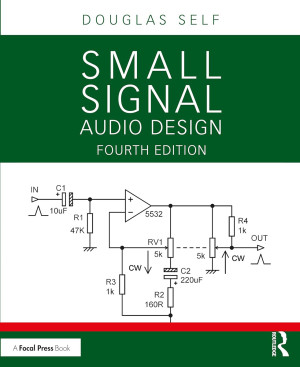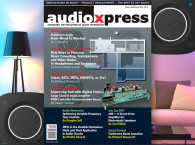 Small Signal Audio Design, 4th edition
Small Signal Audio Design, 4th editionBy Douglas Self, Taylor & Francis, 2024
Amazon softcover/e-book version $60, hardcover edition $100
Page count: 816
ISBN 10: 1032366257
Douglas Self is one of the very few authors writing about technical audio, whether it is power amplifiers, vinyl reproduction preamplifiers, active crossover filters or, as in this case, small-signal circuits for a very wide range of applications.
Self is firmly in the camp of objective and technically sound (no pun intended) design. I once read the adage “Music is Art, Audio is Engineering,” and I suspect that Self would wholeheartedly agree. In that, he had great rapport with the legendary Peter Baxandall, with whom he frequently communicated about audio design [1].
This book deals with small-signal audio design: the amplification, modification, and control of audio in the analogue domain, where the processing is done with op-amps or discrete transistors or field-effect transistors (FETs), usually working at a nominal signal level of a volt or less.
The book contains 27 chapters and a very detailed Index, allowing you to quickly find a relevant section. I will not list all the chapters, sub-chapters, and sub-sub-chapters; you can easily look up those details.
But let me first give you an idea of Self’s perspective. As the author explains in the Preface, even in this highly digitized world, there is still a need for high-performance analog circuits. Take for example the connection of a microphone signal to a digital audio workstation (DAW). There is no way you can bring that mic signal directly into an analog-to-digital converter (ADC)—you need to bridge at least 60dB or 80dB of analog amplification. In fact, because of the very high performance of present-day digital and DSP systems, the performance requirements for the analog part only increase.
Noise and noise minimization is a constant subject throughout the book. Self prefers low impedance designs because they make it easier to minimize noise. This is another important requirement, precisely because of the current high-performance A/D and D/A systems. (There is a full chapter on interconnecting analog signals with the digital world). Low impedance design reduces the effects of Johnson or current noise without adversely affecting voltage noise. It sometimes requires op-amps with increased drive capabilities, so you can either parallel several low-cost op-amps or resort to one of the newer crops high output drive types.
Self also addresses what he calls “numerical noise,” by which he means deviations from calculated component values due to limited availability. The range of available nominal resistance values goes up to the E192 range having values that differ only by a percent or so, but those can be very hard to get. Capacitor value ranges are much more granular, and parts tolerances of better than 5% are often only available for selected values and/or at premium prices. Self makes up specific values with several parallel or series combinations to get to a precise value. This is a great way to obtain precise performance, for instance in RIAA shaping networks and active crossovers. His approach to zoom in on those precise values is quite valuable.
Speaking of RIAA networks, Self examines the four ways to connect resistors and capacitors to obtain the required curve, each offering similar performance. He then selects the solution that requires the lowest value and thus the lowest expenditure for the precision capacitors. This is a recurring theme and shows his commercial design experience in developing high-performance circuits that do not cost an arm and a leg. As he says, often it’s better to throw more thinking at a problem instead of more money.
Easing Into Circuit Design
Self does not jump feet first into circuit design but, sensibly, starts off with a basic chapter on subjects such as amplifier classes, negative feedback (without which op-amps circuits simply would not exist), gain structures, phase perception (important to cut through the forest of opinions on whether phase is or is not audible), and several extended sections on noise sources and their minimization. Next is a chapter on components, their pertinent properties, and imperfections. Nice.
It is after those preliminaries that he gets into the discrete transistor circuits, op-amps, and their properties with a separate chapter about op-amps for low voltages, used in +5V and +3.3V supply systems. Several specific op-amp types are examined to unravel their fitness for specific requirements, such as which op-amp would be best when you want to amplify a signal from a high source impedance. All extensively documented using Audio Precision equipment and other types of measurements. It is in this section where I would have liked to see some discussion about the latest crop of high-performance CMOS and FET op-amps, such as the OPA1656 and the OPA164x series from Texas Instruments (ADI has similar offerings). Although, Self does a great job of convincing the reader that there are surprisingly few applications that would require an op-amp 20 or 50 times more expensive than the NE5534/NE5532 series!
Checking Out Some of the Chapters
After a chapter on filters, the main building blocks are defined, and system design is next with a chapter on preamp architecture and variable gain stages. Next, some chapters on specific applications such as moving magnet and moving coil preamps, tape replay (you would be surprised how popular vintage open reel tape decks are in recording studios) and guitar preamplifiers. Then on to volume and balance controls, tone controls and equalizers, microphone preamps, line inputs and line outputs, and headphone amps.
Somewhere in between is a chapter about mixer architectures, which I found oddly placed, but there must be some logic to it. Then Self goes into more professional applications such as signal switching, mixer sub-systems, level indication and metering, and gain control elements. This is a different look at gain control than the earlier chapter about volume control and focuses more on specific elements that are more common in mixing desks than in a living room stereo, such as voltage control amplifiers, limiters, noise gates, and the likes.
The book then concludes with chapters about power supplies (very important!), interfacing with the digital domain, and design and experimentation. That last subject isn’t often addressed but is extremely important to get your circuit design and implementation right the first time. We’ve all been in a situation where we rushed what we thought was a great design to a PCB, only to find we overlooked some important aspect and had to start over again. This design and implementation chapter outlines a logical and structured approach to the design process, greatly increasing your chances of getting it right the first time.
Overall Opinion
If you’ve followed so far, you might have noticed that the book addresses both circuit design for consumer audio as well as for professional/studio applications. And you would be right. I can imagine that as a designer of, say, moving magnet preamps, mixer architecture would not be your first priority. But that can change tomorrow, and if you are looking for a smart way to combine inputs and outputs in a multichannel amplifier, you’ll likely find ideas in mixer routing discussions.
If you own other similar books by Douglas Self, such as Electronics for Vinyl or Self on Audio or The Design of Active Crossovers, there is some unavoidable overlap. Personally, I don’t mind that; for instance, both The Design of Active Crossovers and the present book discuss op-amp filter circuits, but from a slightly different angle that increased my understanding.
You may think that as a fourth edition, it would just be a refinement on the three editions that went before it. But although there is naturally much in this book that was also addressed in the previous editions, Self always adds new material and new insights, so even if you own any of the previous editions, it would still be worthwhile to get this new book. If you don’t have any of the previous ones, be aware that these are out of print and often command prices that are a multiple of this new version. Well-written and well-executed books with insightful content like the present one are never cheap, yet people sometimes spend more on a coupling capacitor, money they could have applied elsewhere with more effect if they only had read Self’s books!
As Francis Bacon observed: Scientia potentia est (knowledge is power). This latest work from Douglas Self will give you the insight and understanding to successfully create high-performance small-signal analog audio electronics. Recommended. aX
Routledge link: www.routledge.com/Small-Signal-Audio-Design/Self/p/book/9781032366258
References
[1] Baxandall and Self on Audio Power, Linear Audio Classic, collected papers, ISBN 978-9490929039
This article was originally published in audioXpress, March 2024







